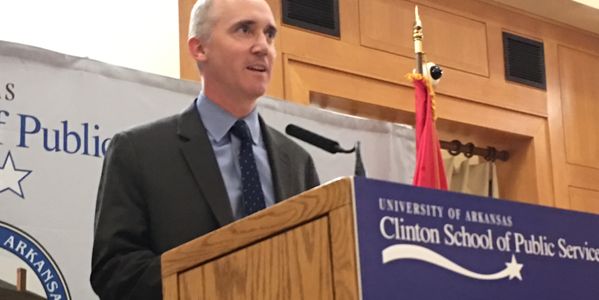AP White House reporter: Midterms a tale of two maps
by October 22, 2018 10:00 am 688 views

AP White House correspondent Ken Thomas.
The midterm elections will be “a tale of two political maps,” with Democrats likely making gains in the House while Republicans have a built-in advantage in the Senate, said Ken Thomas, Associated Press White House correspondent.
Meanwhile, he said, “I don’t think you can underestimate the degree to which President Trump hangs over these midterms.”
Thomas, who has covered the White House for the past two years and previously covered Hillary Clinton, spoke at the Clinton School of Public Service Thursday (Oct. 18).
Democrats need 23 seats to reclaim the House majority, and history shows a president’s party loses about that many in his first midterm election. Thomas said Democratic Congressional Campaign Committee strategists told him they have expanded the number of districts in which they are competing. In 2016, they considered 40 races to be competitive and invested in 28. This time, they invested in nearly 80. Many of those competitive seats are in suburban regions of the country.
“Democrats have been very effective in drawing a big map, getting a lot of seats out there that are competitive,” he said.
National Republican Congressional Committee strategists believe they have a narrow path to maintaining control. If they have a good night, they will lose 17 or 18 seats, he said.
Thomas said races to watch include Kentucky’s 6th District, where Rep. Andy Barr, a Republican, faces challenger and Marine fighter pilot Amy McGrath. This will be one of the first races to report Nov. 6 and could foretell the rest of the evening. Another race to watch on election night will be Virginia’s 10th, a Washington, D.C., suburb where Rep. Barbara Comstock, a Republican, faces Democratic challenger Jennifer Wexton. That race could offer insight into how suburbs and college-educated women are voting.
Two states to watch are Minnesota, where four seats are in play, and California, where five seats carried by Clinton in 2016 are represented by Republicans.
The Senate map, meanwhile, is much more favorable to Republicans. Of the 35 contested seats, 26 are held by Democrats – 10 of those in states Trump won. The focus will be on competitive seats held by Democrats in states the party struggles to win: West Virginia, Montana, North Dakota, Indiana, and Missouri.
Elsewhere, Democratic challenger Beto O’Rourke has raised millions of dollars in his bid to unseat Texas Sen. Ted Cruz. However, Democrats have not won a statewide race in Texas since 1994. In red state Tennessee, former Democratic governor Phil Bredesen has been competitive in his race against Trump ally Rep. Marsha Blackburn, but she’s probably the favorite to win. Democrats thought they could win in Nevada, the only contested race where an incumbent Republican represents a state won by Clinton. But Sen. Dean Heller has proven to be a strong candidate, he said.
Florida’s Senate race will be interesting race because it’s a diverse state whose politics has been upended by the devastation caused by Hurricane Michael. Republican Gov. Rick Scott has suspended his campaign to unseat Sen. Ben Nelson so he can respond to the disaster.
After the votes are counted, the parties will hold their leadership elections. If the Democrats take control by a comfortable margin, Minority Leader Nancy Pelosi likely will become House Speaker, he said. But many Democrats have said they will not vote for her. If the majority is narrow enough, Rep. James Clyburn of South Carolina or Rep. Hakeem Jeffries could emerge. Republican Speaker Paul Ryan is retiring from Congress. Rep. Kevin McCarthy of California could take his place. But if Republicans lose the House, there could be a contest involving him, Rep. Steve Scalice of Louisiana, and Rep. Jim Jordan of Ohio.
The other thing to watch after the midterms is a possible government shutdown. The Homeland Security budget is appropriated through Dec. 7. There could be a brouhaha over funding for Trump’s border wall, especially if Republicans have a bad election and Trump wants a fight, Thomas said.
Thomas said Trump has been “pretty omnipresent” in this campaign. He has nationalized the election, appearing at about 70 political events and telling voters that a vote for the Republican candidate is a vote for him.
Thomas spoke little of his day-to-day coverage of Trump. He said it’s an intense assignment requiring him to respond to after-hours tweets and Fox News appearances. When the president speaks, it’s news, but he tries to keep his coverage focused on how the president’s actions are affecting people.
